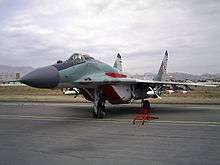Peruvian Armed Forces
| Peruvian Armed Forces Fuerzas Armadas del Perú | |
|---|---|
| Founded | 1821 |
| Service branches |
Peruvian Army Peruvian Navy Peruvian Air Force |
| Headquarters | Lima |
| Leadership | |
| Commander-in-Chief | President Pedro Pablo Kuczynski |
| Minister of Defence | Peter Cateriano Bellido |
| Chief of Defense | General Leonel Cabrera Pino[1] |
| Manpower | |
| Military age | 18 |
| Conscription | Yes |
| Available for military service | 7,920,056, age 17-45[2] |
| Fit for military service | 6,045,256, age 17-45[3] |
| Reaching military age annually | 312,375 |
| Active personnel | 120,658 (2001)[4] |
| Expenditures | |
| Percent of GDP | 1.5% (2006 est.) |
| Industry | |
| Foreign suppliers |
|
The Peruvian Armed Forces (Spanish: Fuerzas Armadas del Perú) are the military services of Peru, comprising independent Army, Navy and Air Force components. Their primary mission is to safeguard the country's independence, sovereignty and territorial integrity against any threat. As a secondary mission they participate in economic and social development as well as in civil defense tasks.[5]
The National Police of Peru is often classified as a part of the armed forces. Although in fact it has a different organisation and a wholly civil mission, its training and activities over more than two decades as an anti-terrorist force have produced markedly military characteristics, giving it the appearance of a virtual fourth military service with significant land, sea and air capabilities and approximately 140,000 personnel. The Peruvian armed forces report through the Ministry of Defense, while the National Police of Peru, through the Ministry of Interior.
Army
Headquartered in Lima, it has a strength of 76,228 troops divided in four military regions with headquarters in Piura, Lima, Arequipa and Iquitos. Every military region is assigned several brigades of which there are different types, including infantry, cavalry and armored. There are also several groups and battalions which operate independently.
The equipment of the Peruvian Army includes several types of tanks (T-55 and AMX-13), armoured personnel carriers (M-113, UR-416), artillery (D30, M101, M109 and M114 howitzers), antiaircraft systems (ZSU-23-4 Shilka) and helicopters (Mil Mi-2, Mil Mi-17).
Navy

Peruvian Navy (Marina de Guerra del Perú) is organized in five naval zones headquartered in Piura, Lima, Arequipa, Iquitos and Pucallpa. It has a strength of around 25,988 troops divided between the Pacific Operations and the Amazon Operations General Commands and the Coast Guard.
The Pacific fleet flagship is the guided-missile cruiser BAP Almirante Grau (CLM-81), named for the 19th-century Peruvian Admiral who fought in the War of the Pacific (1879–1883). The fleet also includes 8 Lupo class frigates (two built in Peru), 6 PR-72P class corvettes, 3 Terrebonne Parish class landing ships, 2 Type 209/1100 and 4 Type 209/1200 class German-built diesel submarines (the biggest submarine force in South America), as well as patrol vessels, tankers and cargo ships. Peruvian Navy has also a naval aviation force, several naval infantry battalions and special forces units.
Air Force

On May 20, 1929, the aviation divisions of the Peruvian army and navy were merged into the Peruvian Aviation Corps (CAP, Cuerpo de Aviación del Peru). In 1950, the corps was reorganized again and became the Peruvian Air Force (FAP, Fuerza Aérea del Perú).
The Peruvian Air Force is divided into 6 wing areas, headquartered in Piura, Chiclayo, Lima, Arequipa, Rioja and Iquitos. With a strength of 17,969 troops, the FAP counts in its arsenal with MiG-29 (interceptor) and Mirage 2000 (interdictor / multirole aircraft).
It also has Su-25 close-support aircraft, Mi-25 attack helicopters, Mi-17 transport helicopters, Aermacchi MB-339, Embraer EMB-312 Tucano subsonic training aircraft, and the Cessna A-37B for light attack and COIN missions.
In 1995, the FAP took part in the Cenepa War against Ecuador covering operations by the army and navy. After the war, the FAP began acquiring new material, especially MiG-29 fighters and Su-25 close air support aircraft which are, along with the Mirage 2000 fighters, the main combat elements of the FAP.
See also
References
- ↑ General Leonel Cabrera Pino reemplaza a José Cueto en el Comando Conjunto
- ↑ Ley Nº 27178 Ley del Servicio Militar, http://www.ejercito.mil.pe/transpar/dispos_legales/ley27178.doc
- ↑ Ley Nº 27178 Ley del Servicio Militar, http://www.ejercito.mil.pe/transpar/dispos_legales/ley27178.doc
- ↑ http://www.resdal.org/art-rial.htm, based on Supreme Decree DS No. 69 DE/SG of 2001.
- ↑ Ministerio de Defensa, Libro Blanco de la Defensa Nacional. Ministerio de Defensa, 2005, 90.
External links
| Wikimedia Commons has media related to Military of Peru. |
- Ministry of Defence (Spanish)
- Official army website (Spanish)
- Official air force website (Spanish)
- Official navy website (Spanish)